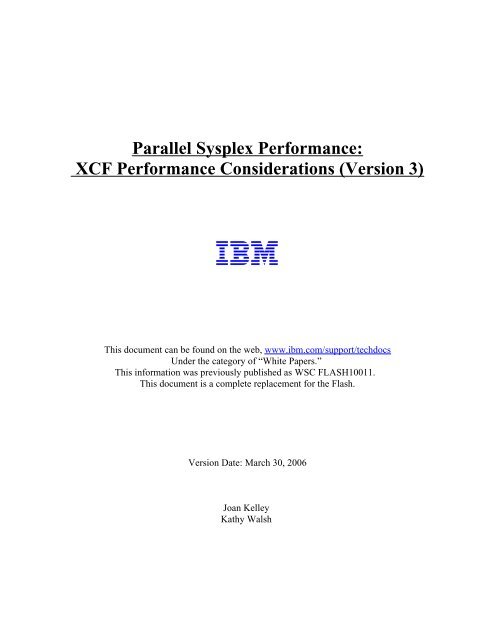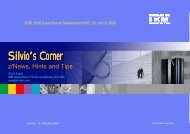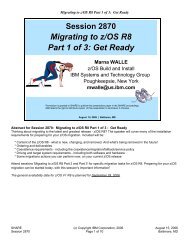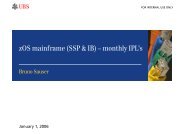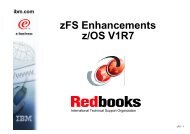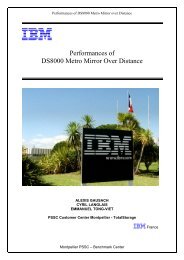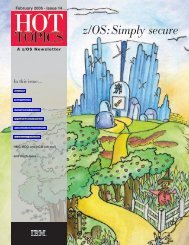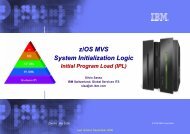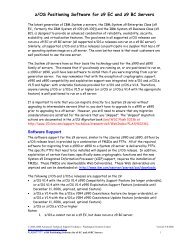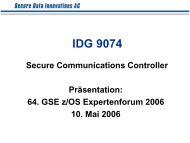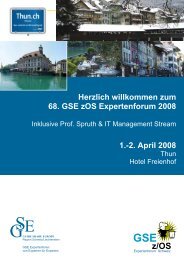Xcf Performance Considerations - Messmer The Brain House
Xcf Performance Considerations - Messmer The Brain House
Xcf Performance Considerations - Messmer The Brain House
Create successful ePaper yourself
Turn your PDF publications into a flip-book with our unique Google optimized e-Paper software.
Parallel Sysplex <strong>Performance</strong>:<br />
XCF <strong>Performance</strong> <strong>Considerations</strong> (Version 3)<br />
IBM<br />
This document can be found on the web, www.ibm.com/support/techdocs<br />
Under the category of “White Papers.”<br />
This information was previously published as WSC FLASH10011.<br />
This document is a complete replacement for the Flash.<br />
Version Date: March 30, 2006<br />
Joan Kelley<br />
Kathy Walsh
Overview<br />
Some installations implementing parallel sysplex have seen performance issues due to XCF<br />
signaling. <strong>The</strong>se performance issues are generally solved by tuning changes to the XCF<br />
transport class definitions, buffer definitions, and signaling paths. This document is intended to<br />
review recommended XCF configurations and known performance tuning options.<br />
This document has been updated in Version 3 to add information on:<br />
� New MAXMSG recommendations<br />
� New signaling performance information when using FICON CTCs<br />
� New display commands<br />
Tuning XCF<br />
XCF signaling is used to communicate between various members of a sysplex. <strong>The</strong> user of XCF<br />
signaling, usually an MVS component or a subsystem, issue messages to members within the<br />
user's group. <strong>The</strong> content and/or use of these messages are unique to the users of the group.<br />
As XCF messages are generated, they are assigned to a transport class based on group name<br />
and/or message size. <strong>The</strong> messages are copied into a signal buffer from the XCF buffer pool.<br />
<strong>The</strong> messages are sent over outbound paths, (PATHOUT), defined for the appropriate transport<br />
class. Messages from other systems are received by inbound paths, (PATHIN). Inbound paths<br />
are not directly assigned transport classes, although a correlation can be made about which<br />
transport class messages are received via the inbound paths based on the outbound path to which<br />
the inbound side is connected.<br />
<strong>The</strong> following is a diagram which highlights the XCF message traffic.<br />
System 1<br />
Buffer<br />
Pathout<br />
Pathin<br />
Pool Pathout<br />
Pathin<br />
Buffer<br />
Pool<br />
Pathout<br />
System 2<br />
Pathin<br />
Buf Pool<br />
Buf Pool<br />
Buf Pool<br />
<strong>The</strong> key to ensuring good performance for the XCF signaling service is to provide sufficient<br />
signaling resources, namely message buffers, message buffer space, and signaling paths, and to<br />
control access to those resources with the transport class definitions.<br />
© 2001, 2006, IBM Corporation, zSeries <strong>Performance</strong> Version Date: 3/30/2006<br />
http://www.ibm.com/support/techdocs Page 1<br />
XCF <strong>Performance</strong> <strong>Considerations</strong> (V3)
Transport Classes<br />
Transport classes are used to group messages. Using the CLASSDEF parameter in the<br />
COUPLExx parmlib member you can assign messages to a transport class based on the group<br />
name, the message size, or both.<br />
Each transport class has its own resources which consists of a buffer pool and one or more<br />
outbound signaling paths. It is recommended you keep the number of transport classes small. In<br />
most cases, it is more efficient to pool the resources and define the transport class based on<br />
message size. Some initial product documentation recommended separate transport classes for<br />
GRS or RMF. <strong>The</strong>se recommendations are no longer advised. If you do have separate transport<br />
classes for specific groups based on early product recommendations you should consider<br />
changing these definitions.<br />
Message Buffers<br />
XCF message buffers are managed by correctly selecting the size of the message most frequently<br />
sent from specific buffer pools and by specifying an adequate upper limit for the size of the<br />
buffer pool.<br />
Message Buffer Size<br />
First let's look at the individual message buffer size definitions. Message buffer size is<br />
determined by the CLASSLEN parameter on the CLASSDEF statement in the COUPLExx<br />
parmlib member. An example of this specification in the COUPLExx parmlib member is:<br />
CLASSDEF CLASS(DEFSMALL) CLASSLEN(956) GROUP(UNDESIG)<br />
CLASSDEF CLASS(DEFAULT) CLASSLEN(16316) GROUP(UNDESIG)<br />
<strong>The</strong> CLASSLEN value determines the size of the most frequent message expected in this<br />
transport class. If a message could be assigned to more than one transport class, XCF selects the<br />
one with the smallest buffer which will hold the message. If the signal is larger than the<br />
CLASSLEN for any of the assigned transport classes, XCF has to choose a transport class to<br />
expand. XCF assigns the message to the transport class with the largest buffer size and expands<br />
the buffer size of this transport class.<br />
Expanding the message buffer entails some overhead. <strong>The</strong> PATHOUT on the sending side and<br />
the PATHIN on the receiving side must be cleared out and expanded to handle the larger buffer<br />
size. A new, larger buffer must be obtained on the PATHIN side. If no additional messages of<br />
this size are received in a short time period, XCF then contracts the PATHIN, PATHOUT, and<br />
buffer sizes. In both of these cases extra XCF internal signals are generated to communicate<br />
these changes.<br />
<strong>The</strong> best way to eliminate the overhead of expanding and contracting the message buffers is to<br />
define transport classes based solely on the size of the message buffers. One class with the<br />
default length of 956 should handle most of the traffic. A second class can be defined to handle<br />
larger messages.<br />
© 2001, 2006, IBM Corporation, zSeries <strong>Performance</strong> Version Date: 3/30/2006<br />
http://www.ibm.com/support/techdocs Page 2<br />
XCF <strong>Performance</strong> <strong>Considerations</strong> (V3)
<strong>The</strong> parameter GROUP(UNDESIG) specifies the messages should be assigned to the transport<br />
class based solely on message size. This definition makes all the resources available to all users<br />
and provides everyone with peak capacity.<br />
<strong>The</strong>re may be times when you want a separate transport class for a specific group. For instance,<br />
if you have a particular XCF user which is consuming a disproportionate amount of XCF<br />
resources, you may want to isolate this user to a separate transport class to investigate the user’s<br />
behavior and protect the other XCF users. Hopefully, after you have diagnosed the problem, you<br />
can reassign this user to a transport class based on the length of the messages. XCF can<br />
dynamically add and delete transport classes by using the SETXCF command.<br />
You can use an RMF XCF report to determine how well the messages fit:<br />
XCF USAGE BY SYSTEM<br />
-----------------------------------------------------------------------<br />
REMOTE SYSTEMS<br />
-----------------------------------------------------------------------<br />
OUTBOUND FROM JB0<br />
-----------------------------------------------------------------------<br />
----- BUFFER -----<br />
TO TRANSPORT BUFFER REQ % % % % ....<br />
SYSTEM CLASS LENGTH OUT SML FIT BIG OVR<br />
JA0 DEFLARG 16,316 189 98 1 1 100<br />
DEFAULT 956 55,794 0 100 0 0<br />
JB0 DEFLARG 16,316 176 100 0 0 0<br />
DEFAULT 956 44,156 0 100 0 0<br />
JC0 DEFLARG 16,316 176 100 0 0 0<br />
DEFAULT 956 34,477 0 100 0 0 ....<br />
----------<br />
TOTAL 134,968<br />
%SML is the % of messages smaller than the buffer length<br />
%FIT is the % of messages which fit the buffer length<br />
%BIG is the % of messages larger than the buffer length<br />
In this example, the majority of the messages fit in the DEFAULT class. A few exceeded the size<br />
of the DEFLARG class, but not enough to justify the definition of a new transport class.<br />
Note: XCF has internal buffers of fixed size: 1K, 4K, 8K, ..64K. XCF uses 68 bytes for internal control blocks. So<br />
if you specify a length which doesn't fit one of these sizes, XCF will round up to the next largest size. For example,<br />
if you specify 1024, it will not fit into the 1K block (1024-68=956), and XCF will round up to the next largest<br />
block. If you issue a command, D XCF,CLASSDEF, it will list the CLASSLEN specified in the PARMLIB<br />
member, in this example, 1024. <strong>The</strong> RMF XCF report will show the actual buffer length, in this case 4028.<br />
© 2001, 2006, IBM Corporation, zSeries <strong>Performance</strong> Version Date: 3/30/2006<br />
http://www.ibm.com/support/techdocs Page 3<br />
XCF <strong>Performance</strong> <strong>Considerations</strong> (V3)
XCF provides operator commands to dynamically tune transport classes. You can use an<br />
operator command, D XCF,CD,CLASS=ALL to get information about the current behavior of<br />
the XCF transport classes. <strong>The</strong> command has a sysplex level scope and returns information<br />
regarding the size of messages being sent through the transport class sysplex wide and identifies<br />
current buffer usage needed to support the load.<br />
<strong>The</strong> following example shows the data which is returned by the command. In this example the<br />
message output has been edited to display a representative sample of the returned data.<br />
D XCF,CD,CLASS=ALL<br />
IXC344I 09.51.37 DISPLAY XCF 282<br />
TRANSPORT CLASS DEFAULT ASSIGNED<br />
CLASS LENGTH MAXMSG GROUPS<br />
DEFAULT 956 2500 UNDESIG<br />
LARGE 16316 2500 UNDESIG<br />
SMALL 4028 2500 UNDESIG<br />
LARGE TRANSPORT CLASS USAGE FOR SYSTEM SYSA<br />
SUM MAXMSG: 5000 IN USE: 180 NOBUFF: 0<br />
SEND CNT: 296373 BUFFLEN (SML): 8124<br />
SEND CNT: 47 BUFFLEN (SML): 12220<br />
SEND CNT: 282274 BUFFLEN (FIT): 16316<br />
SEND CNT: 10 BUFFLEN (BIG): 20412<br />
SEND CNT: 36 BUFFLEN (BIG): 24508<br />
SEND CNT: 4 BUFFLEN (BIG): 62464<br />
<strong>The</strong> command output will show information on the defined transport classes, and the message<br />
lengths they are processing. It will also show the buffer allocations (MAXMSG). SUM<br />
MAXMSG is the sum of the MAXMSG for the transport class and the MAXMSG values for any<br />
PATHOUTS to this system. For each transport class it will show the size and number of<br />
messages sent via the transport class. To use this command it is necessary to issue the command<br />
twice at some set interval. <strong>The</strong> SEND CNT is a display of internal buckets so it is necessary to<br />
build deltas on the SEND CNTs between the two displayed intervals. With this information you<br />
can determine how the transport classes are being used and if additional transport classes are<br />
needed.<br />
In the example above very few messages are being sent which required a bigger buffer and so the<br />
LARGE transport class is sufficient and no changes need to be made. <strong>The</strong>re is significant traffic<br />
which could use a smaller buffer (8k vs 16k). Sending a smaller message in a larger buffer does<br />
not cause increased XCF overhead but is a less efficient use of buffer space.<br />
Message Buffer Pools<br />
Having determined the optimal size for the individual message buffer, the next thing to do is<br />
select an upper limit for the amount of virtual storage to be allocated to the message buffer pool.<br />
<strong>The</strong> message buffer space is virtual storage used by XCF to store the message buffers which are<br />
being processed, sent or received.<br />
Most of the virtual storage used for this purpose is backed by fixed storage. <strong>The</strong> storage to hold<br />
LOCAL buffers (for communication within the processor) is DREF (disabled reference) storage<br />
which is backed by central storage. LOCAL buffers are used for messages within groups which<br />
are on the same MVS image. Currently APPC and JES3 are the only known IBM exploiters of<br />
© 2001, 2006, IBM Corporation, zSeries <strong>Performance</strong> Version Date: 3/30/2006<br />
http://www.ibm.com/support/techdocs Page 4<br />
XCF <strong>Performance</strong> <strong>Considerations</strong> (V3)
local messages but any ISV application can choose to take advantage of LOCAL message<br />
processing.<br />
XCF only uses the amount of storage it needs to support the load. But to ensure there are no<br />
surprises which stress available central storage, the installation can use the MAXMSG parameter<br />
to place an upper limit on the amount of storage which can be used for this purpose.<br />
XCF storage is associated with the transport class, the outgoing paths, and the incoming paths, so<br />
MAXMSG can be specified on the CLASSDEF, PATHIN and PATHOUT definitions, or more<br />
generally on the COUPLE definition. MAXMSG is specified in 1K units. <strong>The</strong> default values are<br />
determined in the following hierarchy:<br />
OUTBOUND INBOUND<br />
-----------------------------------|---------------------------------<br />
PATHOUT - not specified, use | PATHIN - not specified, use<br />
CLASSDEF - not specified, use | COUPLE<br />
COUPLE |<br />
Prior to z/OS 1.6 the default for MAXMSG is 750. For z/OS 1.6 and later releases the default<br />
for MAXMSG is 2000. <strong>The</strong> value for MAXMSG can be changed dynamically by issuing the<br />
SETXCF Modify command. By not specifying the default parameter in the parmlib definition<br />
you will automatically get the most current default size as you migrate to newer releases.<br />
Significant performance problems have been experienced as a result of insufficient XCF buffers.<br />
<strong>The</strong> default of 750 buffers is too small for most XCF configurations. <strong>The</strong> recommendation is to<br />
set MAXMSG on the COUPLE statement to at least the default of 2000.<br />
For large installation the XCF environment should be reviewed to ensure there are no messages<br />
being rejected for lack of buffers. If there are rejected messages then the MAXMSG value<br />
should be adjusted upwards until the rejected messages are eliminated. While reviewing any<br />
buffer issues it would be worthwhile to ensure an XCF user did not suddenly start issuing many<br />
more messages and this is what is causing the stress on message buffers. Identifying and<br />
correcting excessive use of XCF should be an ongoing performance tuning objective. Simply<br />
adding message buffers without an understanding of the reason for the increased buffer<br />
requirement is just postponing a problem.<br />
<strong>The</strong> total amount of storage used by XCF on a single system is the sum of:<br />
� Sum of MAXMSG for all classes * systems in sysplex<br />
� Sum of MAXMSG for all PATHOUTs<br />
� Sum of MAXMSG for all PATHINs<br />
© 2001, 2006, IBM Corporation, zSeries <strong>Performance</strong> Version Date: 3/30/2006<br />
http://www.ibm.com/support/techdocs Page 5<br />
XCF <strong>Performance</strong> <strong>Considerations</strong> (V3)
In this example:<br />
XCF PATH STATISTICS<br />
------------------------------------------------------------------------<br />
OUTBOUND FROM JB0 INBOUND TO JB0<br />
------------------------------------- --------------------------<br />
T FROM/TO T FROM/TO<br />
TO Y DEVICE, OR TRANSPORT ... FROM Y DEVICE, OR<br />
SYSTEM P STRUCTURE CLASS SYSTEN P STRUCTURE<br />
JA0 S IXCPLEX_PATH1 DEFAULT JA0 S IXCPLEX_PATH1<br />
C C600 TO C614 DEFSMALL C C600 TO C614<br />
C C601 TO C615 DEFSMALL C C601 TO C615<br />
C C602 TO C616 DEFSMALL C C602 TO C616<br />
JB0 S IXCPLEX_PATH1 DEFAULT JB0 S IXCPLEX_PATH1<br />
C C600 TO C614 DEFSMALL C C600 TO C614<br />
C C601 TO C615 DEFSMALL C C601 TO C615<br />
C C602 TO C616 DEFSMALL C C602 TO C616<br />
If a MAXMSG of 2000 was specified on the COUPLE statement and MAXMSG was not<br />
specified on the other parameters, the maximum storage which could be used by XCF is 44M:<br />
� 2 classes * 3 systems * 2M = 12M<br />
� 8 PATHOUTs * 2M = 16M<br />
� 8 PATHINs * 2M = 16M<br />
Note: This calculation implies if you add additional transport classes, signaling paths or systems, you will also be<br />
increasing the upper limit on the size of the message buffer pool.<br />
Outbound Messages<br />
For the outbound messages to a particular system if the sum of the storage for the CLASSDEF<br />
and the PATHOUTs is insufficient, the signal will be rejected. This is reported on the RMF XCF<br />
report as REQ REJECT for OUTBOUND requests. In general, any non-zero value in this field<br />
suggests some further investigation. <strong>The</strong> problem is generally resolved by increasing MAXMSG<br />
on the CLASSDEF or PATHOUT definition.<br />
XCF USAGE BY SYSTEM<br />
------------------------------------------------------------------------<br />
REMOTE SYSTEMS<br />
------------------------------------------------------------------------<br />
OUTBOUND FROM SYSC<br />
------------------------------------------------------------------------<br />
ALL<br />
TO TRANSPORT BUFFER REQ PATHS REQ<br />
SYSTEM CLASS LENGTH OUT UNAVAIL REJECT<br />
K004 DEFAULT 956 126,255 ... 0 1,391<br />
DEF16K 16,316 28 0 0<br />
SYSA DEFAULT 956 97,834 0 0<br />
DEF16K 16,316 3,467 0 0<br />
----------<br />
TOTAL 227,584<br />
© 2001, 2006, IBM Corporation, zSeries <strong>Performance</strong> Version Date: 3/30/2006<br />
http://www.ibm.com/support/techdocs Page 6<br />
XCF <strong>Performance</strong> <strong>Considerations</strong> (V3)
Inbound Messages<br />
For the inbound messages from a particular system if the storage for the PATHINs is insufficient<br />
the signal will be delayed. This is reported on the RMF XCF report as REQ REJECT for<br />
INBOUND requests. If the delay causes signals to back up on the outbound side, eventually an<br />
outbound signal could get rejected for lack of buffer space. In this case, you may wish to<br />
increase the MAXMSG on the PATHIN definition.<br />
XCF USAGE BY SYSTEM<br />
----------------------------------------------------------------------<br />
REMOTE SYSTEMS LOCAL<br />
------------------------------------------------ -----------------<br />
INBOUND TO SYSC SYSC<br />
--------------------------- -----------------<br />
..... FROM REQ REQ TRANSPORT REQ<br />
SYSTEM IN REJECT CLASS REJECT<br />
K004 117,613 1,373 DEFAULT 0<br />
DEF16K 0<br />
SYSA 101,490 0<br />
----------<br />
TOTAL 219,103<br />
Another indicator the storage for PATHINs is insufficient is the BUFFERS UNAVAIL count on<br />
the XCF PATH STATISTICS report. If this is high check the AVAIL and BUSY counts:<br />
AVAIL counts should be high relative to BUSY counts. High BUSY counts can be caused by an<br />
insufficient number of paths or a lack of inbound space. First look at the inbound side to see if<br />
there are any REQ REJECTs. If so, increase the PATHIN MAXMSG. Otherwise, it is important<br />
to review the capacity of the signaling paths. <strong>The</strong> methodology for determining this is described<br />
later in this document.<br />
Note: <strong>The</strong> RMF Communications Device report cannot be used to determine if the CTC devices are too busy. XCF<br />
CTCs will typically always report high device utilization because of the suspend / resume protocol used by XCF.<br />
Local Messages<br />
Local messages are signals within the same image, so no signaling paths are required. In this<br />
case, the message buffer storage used is the CLASSDEF storage plus any storage specified on<br />
the LOCALMSG definition. If MAXMSG is not coded on the LOCALMSG statement the<br />
additional message buffer storage contributed is none (0 buffers.)<br />
Member Usage Information<br />
An XCF group is a set of related members defined to XCF by a multisystem application. A<br />
member is a specific function, or instance, of the application. A member resides on one system<br />
and can communicate with other members of the same group across the sysplex.<br />
Communication between group members on different systems occurs over the signaling paths<br />
connecting the systems; on the same system, communication between group members occurs<br />
through local signaling services.<br />
© 2001, 2006, IBM Corporation, zSeries <strong>Performance</strong> Version Date: 3/30/2006<br />
http://www.ibm.com/support/techdocs Page 7<br />
XCF <strong>Performance</strong> <strong>Considerations</strong> (V3)
To prevent multisystem applications from interfering with one another, each XCF group name in<br />
the sysplex must be unique. Information is provided in the Appendix on which components own<br />
specific group names.<br />
<strong>Performance</strong> problems can often be traced back to an XCF group which dramatically increases<br />
its signaling rate. <strong>The</strong> increased signaling may cause capacity issues and the result may be a<br />
slowdown for both the group with the increased signaling rate as well as all other users of XCF<br />
services. <strong>The</strong> quickest way to determine which XCF group is using more signaling resources is<br />
to use the RMF Usage by Member report. <strong>The</strong> Usage by Member section gives information<br />
about messages sent to and from each remote system, broken down by remote group and<br />
member, and summarizes messages sent and received by the local system (the local system is the<br />
system on which the data was collected) broken down by local group and member. <strong>The</strong><br />
following is an example of the report.<br />
XCF USAGE BY MEMBER<br />
-----------------------------------------------------------------<br />
MEMBERS COMMUNICATING WITH WSC2 MEMBERS ON WSC2<br />
------------------------------------------ -----------------<br />
REQ REQ<br />
FROM TO REQ<br />
GROUP MEMBER SYSTEM WSC2 WSC2 GROUP MEMBER OUT<br />
SYSBPX WSC1 WSC1 488 485 SYSBPX WSC2 16,200<br />
WSC3 WSC3 1,073 1,072 ---------<br />
WSC4 WSC4 11,832 11,825 TOTAL 16,200<br />
WSC5 WSC5 672 672<br />
WSC6 WSC6 2,128 2,117<br />
------- --------<br />
TOTAL 16,193 16,171<br />
SYSGRS WSC1 WSC1 719 719 SYSGRS WSC2 13,773<br />
WSC3 WSC3 1,209 1,208 ----------<br />
WSC4 WSC4 1,284 1,284 TOTAL 13,773<br />
WSC5 WSC5 1,152 1,152<br />
WSC6 WSC6 4,014 3,384<br />
------- --------<br />
TOTAL 8,378 7,747<br />
By reviewing this information across time it should be possible to determine which XCF group<br />
has changed the rate at which it issues messages. Often the cause of the increased signaling is<br />
traced back to a group called IXCLOxxx where xxx is a system generated number. <strong>The</strong>se XCF<br />
groups are dynamically created by XES to manage lock contention on either a lock structure or a<br />
serialized list structure. If an application using either of these structure types begins to<br />
experience increased lock contention one of the byproducts of this increased contention is<br />
increased XCF signaling traffic. This is because XES will use XCF services to perform lock<br />
negotiation for the structure in question.<br />
By using XCF commands it is possible to identify which XCF signaling group is being used to<br />
support structure lock negotiation.<br />
© 2001, 2006, IBM Corporation, zSeries <strong>Performance</strong> Version Date: 3/30/2006<br />
http://www.ibm.com/support/techdocs Page 8<br />
XCF <strong>Performance</strong> <strong>Considerations</strong> (V3)
D XCF,STR,STRNAME=IRLMLOCK1<br />
IXC360I 11.33.11 DISPLAY XCF FRAME 1 F<br />
STRNAME: IRLMLOCK1<br />
STATUS: ALLOCATED<br />
POLICY SIZE : 64000 K<br />
SYSTEM-MANAGED PROCESS LEVEL: 8<br />
...<br />
XCF GRPNAME : IXCLO009<br />
In this example by displaying the lock structure IRLMLOCK1 you can identify the XCF Group<br />
which is going to be used to handle the lock contention. <strong>The</strong> XCF reports can then be used to<br />
understand the impact of the XES created group on XCF signaling resources.<br />
Signaling Paths<br />
XCF signals from each transport class are sent out on the PATHOUT path and received into the<br />
system on the PATHIN paths. Tuning is achieved by altering the number or type of paths, or<br />
both. To review the XCF path configuration use the RMF XCF Path Statistics report. Two<br />
different issues commonly reported to IBM regarding signaling paths are reviewed in this<br />
document: no paths defined, and an insufficient number of paths defined.<br />
Number of Paths<br />
1. No paths<br />
In the worst case, there may be NO operational paths for a transport class. This is not fatal.<br />
XCF routes the requests to another transport class but there is additional overhead associated<br />
with this operation. To determine if this condition exists, look at the RMF XCF Usage by<br />
System report. ALL PATHS UNAVAIL should be low or 0. In many cases this is caused by an<br />
error in the path definition; in other cases there may be a problem with the physical path.<br />
XCF USAGE BY SYSTEM<br />
-----------------------------------------------------------------------<br />
REMOTE SYSTEMS<br />
-----------------------------------------------------------------------<br />
OUTBOUND FROM SD0<br />
-----------------------------------------------------------------------<br />
ALL<br />
TO TRANSPORT BUFFER REQ PATHS REQ<br />
SYSTEM CLASS LENGTH OUT .... UNAVAIL REJECT<br />
JA0 DEFAULT 16,316 189 0 0<br />
DEFSMALL 956 55,794 55,794 0<br />
JB0 DEFAULT 16,316 176 0 0<br />
DEFSMALL 956 44,156 0 0<br />
JC0 DEFAULT 16,316 176 0 0<br />
DEFSMALL 956 34,477 .... 0 0<br />
----------<br />
TOTAL 134,968<br />
In this example, the CTC links to system JA0 had been disconnected.<br />
© 2001, 2006, IBM Corporation, zSeries <strong>Performance</strong> Version Date: 3/30/2006<br />
http://www.ibm.com/support/techdocs Page 9<br />
XCF <strong>Performance</strong> <strong>Considerations</strong> (V3)
In the next example from the same system notice for system JA0 there were no paths for the<br />
transport class DEFSMALL so all the requests were re-driven through the DEFAULT class.<br />
XCF PATH STATISTICS<br />
------------------------------------------------------------------------<br />
OUTBOUND FROM SD0<br />
------------------------------------------------------------------------<br />
T FROM/TO<br />
TO Y DEVICE, OR TRANSPORT REQ AVG Q<br />
SYSTEM P STRUCTURE CLASS OUT LNGTH AVAIL BUSY RETRY<br />
JA0 S IXCPLEX_PATH1 DEFAULT 56,011 0.16 55,894 117 0<br />
JB0 S IXCPLEX_PATH1 DEFAULT 176 0.00 176 0 0<br />
C C600 TO C614 DEFSMALL 16,314 0.01 16,297 17 0<br />
C C601 TO C615 DEFSMALL 15,053 0.01 15,037 16 0<br />
C C602 TO C616 DEFSMALL 15,136 0.01 15,136 20 0<br />
JC0 S IXCPLEX_PATH1 DEFAULT 176 0.00 176 0 0<br />
C C600 TO C614 DEFSMALL 11,621 0.01 11,515 106 0<br />
C C601 TO C615 DEFSMALL 13,086 0.01 12,962 124 0<br />
C C602 TO C616 DEFSMALL 11,626 0.00 11,526 100 0<br />
Is it necessary to correct the 'ALL PATHS UNAVAIL' condition? In most cases it is. In the<br />
example above, DEFSMALL was defined to hold small messages (956). Because there is no<br />
path, they are being re-driven through the DEFAULT class. <strong>The</strong> DEFAULT class is sending<br />
data in large buffers (16,316 bytes). This is certainly not an efficient use of message buffer<br />
storage to transfer a 956 byte message in a 16,316 byte buffer. Re-driving large messages<br />
through a transport class defined with small messages causes more problems. It causes the<br />
buffers in this class to expand and contract with all the extra signaling explained previously.<br />
Defining separate classes is done for a purpose. If you don't provide paths for these classes, it<br />
negates this purpose.<br />
2. Insufficient number of paths<br />
Signaling paths can be CTC links or Coupling Facility structures. In the example above, the<br />
TYP field indicates the connection is a CF structure (S) or a CTC link (C). Since these two types<br />
of paths operate in unique ways different methods are used to evaluate their performance.<br />
a. CF structures:<br />
For CF structures, an insufficient number of PATHOUT links could result in an increase in<br />
the AVG Q LNGTH, and high BUSY counts relative to AVAIL counts. Additional paths are<br />
obtained by defining more XCF signaling structures in the CFRM policy and making them<br />
available for use as PATHOUTs (and/or PATHINs).<br />
Note: RETRY counts should be low relative to REQ OUT for a transport class. A non zero count indicates a<br />
message has failed and was resent. This is usually indicative of a hardware problem.<br />
b. CTCs<br />
CTCs can be configured in a number of ways. <strong>The</strong> installation can define CTC’s as<br />
unidirectional (one PATHOUT or one PATHIN per physical CTC) or bi-directional (one or<br />
more PATHOUTs and PATHINs on a physical CTC). Due to the nature of XCF channel<br />
programs, a unidirectional path definition can achieve the most efficient use of a CTC thus<br />
providing the best XCF response time and message throughput capacity. However, a<br />
unidirectional definition will also require using at least four physical CTCs to configure for<br />
© 2001, 2006, IBM Corporation, zSeries <strong>Performance</strong> Version Date: 3/30/2006<br />
http://www.ibm.com/support/techdocs Page 10<br />
XCF <strong>Performance</strong> <strong>Considerations</strong> (V3)
availability. As will be noted in the capacity planning section below, two paths are usually<br />
sufficient for most systems, thus only those customers with very high XCF activity,<br />
(requiring >=4 paths), should consider using the unidirectional definition.<br />
Using the AVG Q LEN on the RMF XCF report for CTCs is not a good indicator to<br />
determine if there are enough CTCs for a particular transport class. In the case of CTCs<br />
queued requests are added to the CCW chain which can increase efficiency. To insure<br />
capacity for heavier or peak workloads check the channel utilization for the CTCs as reported<br />
on an RMF Channel Activity report. In laboratory testing, acceptable XCF message<br />
response times were observed even at channel utilization of 70% (or 90% when there were<br />
multiple CTCs per transport class). Beyond this threshold, response time degenerated<br />
rapidly.<br />
For CTC definitions the recommendation is to not define multiple device unit addresses for<br />
the same transport class on the same CTC channel. Each device address would look like an<br />
available pathout to XCF. If two signals arrive then XCF may choose to put a signal on each<br />
device address since from the software’s point of view both addresses appear available.<br />
However, once the signals reach the channel subsystem contention will happen. For ESCON<br />
devices one signal will use the channel and the other will have to wait. For FICON devices<br />
both signals can use the channel but the signal data will be interspersed and overall connect<br />
times will potentially include the transfer times of both signals.<br />
<strong>The</strong> multiple pathouts for the same transport class on the same CTC may cause XCF to not<br />
use a pathout on a different CTC or structure which may be available. So the definition may<br />
cause signals to queue to a busy CTC when other signaling resources are available.<br />
Message Transfer Time<br />
An indicator to use to determine if sufficient capacity exists on the signaling path is the Display<br />
XCF command. This command displays the response time of messages on the path as seen by<br />
XCF. <strong>The</strong> MXFER TIME is the mean transfer time in microseconds for up to the last 64 signals<br />
received within the last minute. If the MXFER TIME is acceptable, less than 2 milliseconds, (or<br />
2000 microseconds), there is probably enough signaling path capacity. <strong>The</strong> response times are<br />
provided only on PATHINs.<br />
D XCF,PI,DEVICE=ALL,STATUS=WORKING<br />
IXC356I 12.02.12 DISPLAY XCF 901<br />
LOCAL DEVICE REMOTE PATHIN REMOTE LAST MXFER<br />
PATHIN SYSTEM STATUS PATHOUT RETRY MAXMSG RECORD TIME<br />
C200 JA0 WORKING C200 10 500 3496 339<br />
C220 JA0 WORKING C220 10 500 3640 419<br />
RMF has also provided support for the message transfer time and will store the MXFER TIME<br />
as observed in the last minute before the end of the RMF interval in the RMF SMF 74 subtype 2<br />
record in a field called R743PIOT. This enables a historical view of the performance of the<br />
signaling paths across multiple intervals. This data is in the RMF record but is not formatted on<br />
any of the XCF RMF reports.<br />
© 2001, 2006, IBM Corporation, zSeries <strong>Performance</strong> Version Date: 3/30/2006<br />
http://www.ibm.com/support/techdocs Page 11<br />
XCF <strong>Performance</strong> <strong>Considerations</strong> (V3)
Type of Signaling Path<br />
A CTC provides a direct path between two systems, while sending a message through a CF is a<br />
two step, push-pull process. Thus, depending on message size and the type of CF link, CTCs are<br />
sometimes faster than using CF structures.<br />
<strong>The</strong> chart below shows examples of XCF response time, (MXFER TIME), from controlled<br />
experiments in a test environment on a z990 CEC. <strong>The</strong> three types of CTC configurations have 4<br />
pairs of PATHIN and PATHOUT per physical CTC.<br />
XCF IO Response time (msec)<br />
2.5<br />
2<br />
1.5<br />
1<br />
0.5<br />
0<br />
1K 8K<br />
XCF Message size<br />
32K<br />
ESCON<br />
FICON Ex<br />
FICON Ex2<br />
ISC3<br />
ICB4<br />
A comparison of these examples shows the ESCON CTCs are slightly faster than the FICON<br />
Express CTCs for 1K messages but ESCON is slower when compared to FICON Express 2 as<br />
well as the newer ISC3 and ICB4 links. Though ESCON CTCs are now slower than newer<br />
technology the service times of small (1K) messages on ESCON CTCs are still very acceptable<br />
and may meet the requirements of many XCF users.<br />
For larger messages, the newer CTC technology (FICON and FICON Express) is faster than<br />
ESCON. FICON Express 2 compares favorably to the ISC3 links. For very large messages ICBs<br />
are the fastest option. This results from the higher bandwidth associated with ICB coupling links<br />
compared to CTCs.<br />
© 2001, 2006, IBM Corporation, zSeries <strong>Performance</strong> Version Date: 3/30/2006<br />
http://www.ibm.com/support/techdocs Page 12<br />
XCF <strong>Performance</strong> <strong>Considerations</strong> (V3)
<strong>The</strong> capacity of the different types of links is also an important factor to understand when<br />
planning your XCF configuration. Below is a chart which describes the request rates for the<br />
different technologies when sending 1K messages. This chart shows the point at which the<br />
response time doubled for each type of link, indicating its saturation point.<br />
Thousands<br />
60<br />
50<br />
40<br />
30<br />
20<br />
10<br />
0<br />
Req/sec (1K)<br />
ESCON<br />
FICON Ex<br />
FICON Ex2<br />
ISC3 - z990<br />
ICB4 - z990<br />
High signaling environments may benefit from using ICB and ISC links due to the increased<br />
bandwidth these links afford. Less intense signaling environments may choose to use either<br />
structures or CTCs especially if the majority of the message traffic is small messages.<br />
© 2001, 2006, IBM Corporation, zSeries <strong>Performance</strong> Version Date: 3/30/2006<br />
http://www.ibm.com/support/techdocs Page 13<br />
XCF <strong>Performance</strong> <strong>Considerations</strong> (V3)
XCF internally times the various signals and gives preference to the faster paths. In the following<br />
example, compare the number of requests for DEFSMALL which were sent through the<br />
structure to the number which were sent through the CTCs. It should be noted XCF does not<br />
attempt to balance the workload across paths; once it finds a fast path, it continues to use it.<br />
APAR OW38138 describes changes which improves the path distribution.<br />
XCF PATH STATISTICS<br />
------------------------------------------------------------------------<br />
OUTBOUND FROM JA0<br />
------------------------------------------------------------------------<br />
T FROM/TO<br />
TO Y DEVICE, OR TRANSPORT REQ AVG Q<br />
SYSTEM P STRUCTURE CLASS OUT LNGTH AVAIL BUSY RETRY<br />
JC0 S IXCPLEX_PATH1 DEFAULT 1,744 0.00 1,176 0 0<br />
S IXCPLEX_PATH2 DEFSMALL 8,582 0.01 8,362 220 0<br />
C C600 TO C614 DEFSMALL 20,223 0.01 20,160 63 0<br />
C C601 TO C615 DEFSMALL 23,248 0.01 23,229 19 0<br />
C C602 TO C616 DEFSMALL 23,582 0.01 23,568 14 0<br />
In many environments, the difference in response time between CTCs and CF structures is<br />
indiscernible and using CF structures certainly simplifies management of the configuration.<br />
Capacity Planning<br />
For availability, a minimum of two physical paths must be provided between any two systems.<br />
This can be accomplished with two physical CTCs, structures in each of two different CFs, or a<br />
combination of CTCs and CF structures.<br />
Most environments will find the rate of XCF traffic can be handled by the two paths which were<br />
configured for availability. Only for environments with very high rates of XCF traffic would<br />
additional paths be required.<br />
<strong>The</strong> XCF message rate capacity of a path is affected by many factors:<br />
1. <strong>The</strong> size of the message<br />
2. How the paths are defined<br />
3. If the path is also used for other (non-XCF) functions such as VTAM, or GRS.<br />
Based on these factors, message rates (XCF IN+OUT), have been observed from 1000/sec to<br />
5000/sec on a CTC, up to 9000/sec via an ICB and up to 4000/sec per HiPerLink. <strong>The</strong> adage<br />
"Your mileage may vary" is certainly true here.<br />
When using CF structures for XCF messaging, there is also a cost in CF CPU utilization which<br />
needs to be included in the capacity plan. As an example, running 1000 XCF messages/sec<br />
through an R06 CF would utilize approximately 10% of one CF processor. Additionally, if you<br />
use CF structures as XCF paths, make sure the structure size is adequate. You can use the CF<br />
sizer available on the z/OS website, www.ibm.com/servers/eserver/zseries/cfsizer to obtain an<br />
initial estimate for the structure size. If the structure is too small, you will see an increase in the<br />
number of REQ REJECT and AVG Q LNGTH, and these events will definitely affect response<br />
time.<br />
© 2001, 2006, IBM Corporation, zSeries <strong>Performance</strong> Version Date: 3/30/2006<br />
http://www.ibm.com/support/techdocs Page 14<br />
XCF <strong>Performance</strong> <strong>Considerations</strong> (V3)
CTC Configuration Planning<br />
When configuring CTCs for large volumes of XCF traffic some additional configuration<br />
planning needs to be done. CTC I/O will use SAP capacity, and large XCF environments can<br />
generate I/O rates much higher than traditional DASD and Tape workloads.<br />
<strong>The</strong> SAP acts as an offload engine for the CPUs. Different processor models have different<br />
numbers of SAPs, and, though highly unusual, additional SAP processor may be defined if<br />
needed. SAP functions include:<br />
� Execution of ESA/390 I/O operations. <strong>The</strong> SAP (or SAPs) are part of the I/O subsystem of<br />
the CPC and act as Integrated Offload Processor (IOP) engines for the other processors.<br />
� Machine check handling and reset control<br />
� Support functions for Service Call Logical Processor (SCLP)<br />
In high volume XCF environments planning should be done to ensure the CTC configuration is<br />
defined so the CTC I/O load is spread across all available SAPs. Information on channel to SAP<br />
relationships can be found in the IOCP User’s Guide and ESCON CTC Reference,<br />
GC38-0401-11. With the introduction of the z900 and follow on processors additional<br />
performance information on SAP utilization can be found by using an RMF IOQ Activity report<br />
which records SAP utilization.<br />
Summary<br />
A basic tenet of parallel sysplex performance is to ensure the XCF signaling environment is well<br />
performing. Installations need to ensure sufficient resources have been provided in the areas of<br />
message buffers and signaling paths. It is also important when adding processor capacity to a<br />
parallel sysplex you remember to include the necessary planning to ensure there is adequate XCF<br />
resources to support the anticipated growth.<br />
<strong>The</strong> rest of this document contains additional information on managing an XCF environment.<br />
<strong>The</strong>re is a case study provided which shows a step by step approach for resolving commonly<br />
seen XCF performance problems. <strong>The</strong> case study builds on the information found in the body of<br />
this white paper. <strong>The</strong> Appendix to the document contains important XCF APAR information<br />
and provides information on XCF group names and the z/OS component or program product<br />
which owns the XCF group. It also will contain a representative example of the Couplexx<br />
parameter library for reference. <strong>The</strong> Appendix also contains information on the z/OS Health<br />
Checker and describes XCF related checks which are performed.<br />
XCF when configured for reliability is a robust signaling service. XCF performance data alone<br />
may not be sufficient to understand and resolve performance problems. <strong>The</strong> XCF data should be<br />
paired with more specific application information to get the most complete picture of the<br />
performance of the XCF signaling environment.<br />
© 2001, 2006, IBM Corporation, zSeries <strong>Performance</strong> Version Date: 3/30/2006<br />
http://www.ibm.com/support/techdocs Page 15<br />
XCF <strong>Performance</strong> <strong>Considerations</strong> (V3)
Case Study:<br />
This is a case study which illustrates some of the items discussed.<br />
An application was invoked which was changed to use CF signaling. When the workload was<br />
increased XCF delays increased. This was evident from messages like ERB463I which indicated<br />
the RMF Sysplex Data Server was not able to communicate with another system because the<br />
XCF signaling function was busy.<br />
Looking at RMF Monitor III it showed:<br />
RMF 1.3.0 XCF Delays<br />
Samples: 120 System: J90 Date: 02/07/97 Time: 13.03.00<br />
Service DLY ------------ Main Delay Path(s)<br />
Jobname C Class % % Path % Path % Path<br />
WLM S SYSTEM 87 87 -CF-<br />
*MASTER* S SYSTEM 10 10 -CF-<br />
RMFGAT S SYSSTC 3 3 -CF-<br />
JESXCF S SYSTEM 1 1 C601<br />
Comparing the RMF XCF reports to some earlier reports, it was noticed the amount of XCF<br />
traffic had quadrupled and the increase was in the class with the larger CLASSLEN (DEFAULT<br />
on this system).<br />
In order to protect other XCF users and to investigate what was happening, a decision was made<br />
to separate these messages into their own transport class. A new transport class, NEWXCF, was<br />
defined using the GROUP keyword to specifically assign messages from the new application to<br />
this class. Since it was known the messages were bigger than the transport class with the smaller<br />
CLASSLEN (DEFSMALL), using the new XCF display command to look at actual message<br />
sizes being sent it was decided the messages would fit into a 8K(-68) buffer. This report was<br />
generated:<br />
----- BUFFER ----- ALL<br />
TO TRANSPORT BUFFER REQ % % % % PATHS REQ<br />
SYSTEM CLASS LENGTH OUT SML FIT BIG OVR UNAVAIL REJECT<br />
JA0 DEFAULT 20,412 1,715 90 10 0 0 0 0<br />
DEFSMALL 956 37,687 0 100 0 0 0 0<br />
NEWXCF 8,124 103,063 0 100 0 0 0 3,460<br />
JB0 DEFAULT 20,412 2,075 92 8 0 0 0 0<br />
DEFSMALL 956 38,985 0 100 0 0 0 0<br />
NEWXCF 8,124 117,727 0 100 0 0 0 195<br />
Now all the messages fit, but some are being rejected. This suggests message buffer space for the<br />
outbound path is no longer large enough.<br />
© 2001, 2006, IBM Corporation, zSeries <strong>Performance</strong> Version Date: 3/30/2006<br />
http://www.ibm.com/support/techdocs Page 16<br />
XCF <strong>Performance</strong> <strong>Considerations</strong> (V3)
<strong>The</strong> XCF path statistics confirm outbound messages are queuing up.<br />
TO Y DEVICE, OR TRANSPORT REQ AVG Q<br />
SYSTEM P STRUCTURE CLASS OUT LNGTH AVAIL BUSY<br />
JA0 S IXCPLEX_PATH1 DEFAULT 1,715 0.00 1,715 0<br />
S IXCPLEX_PATH2 DEFSMALL 486 0.00 486 0<br />
S IXCPLEX_PATH3 NEWXCF 103,063 1.42 102,818 245<br />
C C600 TO C584 DEFSMALL 13,644 0.00 13,644 0<br />
C C601 TO C585 DEFSMALL 13,603 0.00 13,603 0<br />
C C602 TO C586 DEFSMALL 12,610 0.00 12,610 0<br />
JB0 S IXCPLEX_PATH1 DEFAULT 2,075 0.00 2,075 0<br />
S IXCPLEX_PATH2 DEFSMALL 737 0.00 737 0<br />
S IXCPLEX_PATH3 NEWXCF 117,727 1.26 117,445 282<br />
C C610 TO C584 DEFSMALL 16,391 0.00 16,391 0<br />
C C611 TO C585 DEFSMALL 12,131 0.01 12,131 0<br />
C C612 TO C586 DEFSMALL 12,294 0.00 12,294 0<br />
Increasing the MAXMSG on the PATHOUT for the NEWXCF transport class from 1000 to<br />
2000 clears up the queuing delays.<br />
----- BUFFER ----- ALL<br />
TO TRANSPORT BUFFER REQ % % % % PATHS REQ<br />
SYSTEM CLASS LENGTH OUT SML FIT BIG OVR UNAVAIL REJECT<br />
JA0 DEFAULT 20,412 2,420 93 7 0 0 0 0<br />
DEFSMALL 956 41,215 0 100 0 0 0 0<br />
VTAMXCF 8,124 133,289 0 100 0 0 0 0<br />
JB0 DEFAULT 20,412 2,362 93 7 0 0 0 0<br />
DEFSMALL 956 39,302 0 100 0 0 0 0<br />
VTAMXCF 8,124 143,382 0 100 0 0 0 0<br />
<strong>The</strong> BUSY conditions are reduced, and more importantly the AVG Q LNGTH has been greatly<br />
reduced. Since the pathout with the contention is a coupling facility structure AVG Q LNGTH is<br />
an appropriate metric to use when tuning.<br />
T FROM/TO<br />
TO Y DEVICE, OR TRANSPORT REQ AVG Q<br />
SYSTEM P STRUCTURE CLASS OUT LNGTH AVAIL BUSY<br />
JA0 S IXCPLEX_PATH1 DEFAULT 2,420 0.00 2,420 0<br />
S IXCPLEX_PATH2 DEFSMALL 361 0.00 361 0<br />
S IXCPLEX_PATH3 NEWXCF 133,289 0.08 133,117 2<br />
C C600 TO C584 DEFSMALL 12,700 0.00 12,700 0<br />
C C601 TO C585 DEFSMALL 16,421 0.00 16,421 0<br />
C C602 TO C586 DEFSMALL 14,173 0.00 14,173 0<br />
JB0 S IXCPLEX_PATH1 DEFAULT 2,362 0.00 2,362 0<br />
S IXCPLEX_PATH2 DEFSMALL 1,035 0.00 1,033 2<br />
S IXCPLEX_PATH3 NEWXCF 143,382 0.09 143,086 296<br />
C C610 TO C584 DEFSMALL 12,647 0.00 12,646 1<br />
C C611 TO C585 DEFSMALL 15,944 0.00 15,944 0<br />
C C612 TO C586 DEFSMALL 12,183 0.00 12,182 1<br />
When determining how to tune the application to limit the number of XCF messages, a DEF8K<br />
transport class for UNDESIG messages was created and the NEWXCF class assigned to this<br />
application was eliminated.<br />
Note: In this case study, the messages were being queued because the message buffer space was too small. If,<br />
instead of REJECTS, there was a high percentage of messages marked as BUSY, then increasing the number of<br />
signaling paths would have been appropriate.<br />
© 2001, 2006, IBM Corporation, zSeries <strong>Performance</strong> Version Date: 3/30/2006<br />
http://www.ibm.com/support/techdocs Page 17<br />
XCF <strong>Performance</strong> <strong>Considerations</strong> (V3)
Incidentally the path associated with the NEWXCF was a CF structure. <strong>The</strong> structure was<br />
chosen since it was quicker and easier to implement. Since the structure was receiving over 500<br />
req/sec, it was unclear if the structure could handle the traffic. As can be seen from the queue<br />
lengths, it was capable of handling this rate.<br />
© 2001, 2006, IBM Corporation, zSeries <strong>Performance</strong> Version Date: 3/30/2006<br />
http://www.ibm.com/support/techdocs Page 18<br />
XCF <strong>Performance</strong> <strong>Considerations</strong> (V3)
Special Notices<br />
This publication is intended to help the customer manage an z/OS Parallel Sysplex environment. <strong>The</strong> information in<br />
this publication is not intended as the specification of any programming interfaces provided by z/OS. See the<br />
publication section of the IBM programming announcement for the appropriate z/OS release for more information<br />
about what publications are considered to be product documentation. Where possible it is recommended to<br />
follow-up with product related publications to understand the specific impact of the information documented in this<br />
publication.<br />
<strong>The</strong> information contained in this document has not been submitted to any formal IBM test and is distributed on an<br />
"as is" basis without any warranty either expressed or implied. <strong>The</strong> use of this information or the implementation of<br />
any of these techniques is a customer responsibility and depends on the customer’s ability to evaluate and integrate<br />
them into the customer’s operational environment. While each item may have been reviewed by IBM for accuracy<br />
in a specific situation, there is no guarantee the same or similar results will be obtained elsewhere. Customers<br />
attempting to adapt these techniques to their own environments do so at their own risk.<br />
<strong>Performance</strong> data contained in this document was determined in a controlled environment; therefore the results<br />
which may be obtained in other operating environments may vary significantly. No commitment as to your ability<br />
to obtain comparable results is any way intended or made by this release of information.<br />
© 2001, 2006, IBM Corporation, zSeries <strong>Performance</strong> Version Date: 3/30/2006<br />
http://www.ibm.com/support/techdocs Page 19<br />
XCF <strong>Performance</strong> <strong>Considerations</strong> (V3)
Appendix<br />
APARS<br />
<strong>The</strong> following APARs are directly related to XCF performance and/or RMF reporting of XCF<br />
performance:<br />
z/OS 1.4 HIPER XCF APARS<br />
OW 51741 OA03359 OA02703 OA06505 OA01597<br />
OA09731 OW 54474 OA05330 OW 56113 OW 57715<br />
OW 57730 OA04616 OW 54072 OA08462 OA07138<br />
OA09388 OA05229 OW 54315 OW 55966 OW 56630<br />
OA02087 OW 55305 OA02585 OW 55429 OA08556<br />
OA05232 OA06436 OA10351 OA06620 OW 56611<br />
OW 53849 OW 54542 OA03126 OW 56355 OW 56369<br />
OA10868 OA05163 OA05391 OA08486 OA10197<br />
OA02080 OW 56633 OA05025 OW 55992<br />
OA04344 OA07640 OW 54685 OW 55711<br />
z/OS 1.6 HIPER APARS<br />
OA06505 OA04616<br />
OA08556 OA05690<br />
OA06620 OA06436<br />
OA07640 OA08462<br />
OA10197 OA08486<br />
OA09388<br />
OW 56611<br />
OA10351<br />
OA09731<br />
OA10868<br />
© 2001, 2006, IBM Corporation, zSeries <strong>Performance</strong> Version Date: 3/30/2006<br />
http://www.ibm.com/support/techdocs Page 20<br />
XCF <strong>Performance</strong> <strong>Considerations</strong> (V3)
XCF Users<br />
<strong>The</strong> following is a list of known XCF groups and the products/components which use them.<br />
GROUP<br />
AOFSMGRP<br />
ASFBGRP1<br />
ATRRRS<br />
BBGROUP<br />
COFVLFNO<br />
DFHIR000<br />
DSNDB1G<br />
DXRDBZG<br />
EJESEJES<br />
ESCM<br />
EZBTCPCS<br />
IDAVQUIO<br />
IGWXSGIS<br />
IRLMGRP1<br />
IRRXCF00<br />
ISTCFS01<br />
ISTXCF<br />
IXCLOxxx<br />
JES2xx<br />
JES3xx<br />
POKUTC58<br />
SYSATBxx<br />
SYSBPX<br />
SYSDAE<br />
SYSENF<br />
SYSGRS<br />
SYSIEFTS<br />
SYSIGW00<br />
SYSIKJBC<br />
SYSIOS<br />
SYSJES<br />
SYSMCS<br />
SYSMCS2<br />
SYSRMF<br />
SYSWLM<br />
OWNER<br />
AOC<br />
AOC<br />
* RRS<br />
CPSM<br />
* VLF<br />
CICS<br />
DB2<br />
DB2<br />
EJES<br />
ESCOM MGR<br />
BatchPipes<br />
VSAM<br />
VSAM RLS<br />
IRLM<br />
RACF<br />
VTAM<br />
VTAM<br />
*# XES<br />
$JES2 MAS<br />
@JES3 Cmplx<br />
NJE-JES2<br />
APPC<br />
Shared HFS<br />
* DAE<br />
* ENF<br />
* GRS<br />
* ALLOCAS<br />
DF/SMS - PDSE<br />
* TSO<br />
* IOS<br />
* JES<br />
* CONSOLES<br />
* CONSOLES<br />
RMF<br />
* WLM<br />
* denotes MVS component<br />
# one for each lock and serialized list<br />
structure<br />
JES2xx - Local node name<br />
JES3xz - Node name on NJERMT init stmt<br />
© 2001, 2006, IBM Corporation, zSeries <strong>Performance</strong> Version Date: 3/30/2006<br />
http://www.ibm.com/support/techdocs Page 21<br />
XCF <strong>Performance</strong> <strong>Considerations</strong> (V3)
Sample COUPLExx PARMLIB member<br />
This PARMLIB member defines two transport classes:<br />
DEFSMALL - used for messages 956, defined with 1 PATHOUT<br />
1 CF structure named IXCPLEX_PATH1.<br />
Since this is an z/OS 1.6 system, the MAXMSG default of 2000 is used for everything except<br />
the PATHIN and PATHOUT paths which use structures.<br />
CLASSDEF CLASS(DEFAULT) CLASSLEN(16316) GROUP(UNDESIG)<br />
CLASSDEF CLASS(DEFSMALL) CLASSLEN(956) GROUP(UNDESIG)<br />
LOCALMSG MAXMSG(2000) CLASS(DEFSMALL)<br />
PATHOUT CLASS(DEFSMALL) MAXMSG(2000) STRNAME(IXCPLEX_PATH2)<br />
PATHOUT CLASS(DEFAULT) MAXMSG(3000) STRNAME(IXCPLEX_PATH1)<br />
PATHIN MAXMSG(2000) STRNAME(IXCPLEX_PATH1,IXCPLEX_PATH2)<br />
PATHOUT CLASS(DEFSMALL) DEVICE(C400,C410,C580,C590,C600,C610)<br />
PATHOUT CLASS(DEFSMALL) DEVICE(C620,C630,C640,C650)<br />
PATHIN DEVICE(C404,C414,C584,C594,C604,C614)<br />
PATHIN DEVICE(C624,C634,C644,C654)<br />
PATHOUT CLASS(DEFSMALL) DEVICE(C401,C411,C581,C591,C601,C611)<br />
PATHOUT CLASS(DEFSMALL) DEVICE(C621,C631,C641,C651)<br />
PATHIN DEVICE(C405,C415,C585,C595,C605,C615)<br />
PATHIN DEVICE(C625,C635,C645,C655)<br />
PATHOUT CLASS(DEFSMALL) DEVICE(C402,C412,C582,C592,C602,C612)<br />
PATHOUT CLASS(DEFSMALL) DEVICE(C622,C632,C642,C652)<br />
PATHIN DEVICE(C406,C416,C586,C596,C606,C616)<br />
PATHIN DEVICE(C626,C636,C646,C656)<br />
© 2001, 2006, IBM Corporation, zSeries <strong>Performance</strong> Version Date: 3/30/2006<br />
http://www.ibm.com/support/techdocs Page 22<br />
XCF <strong>Performance</strong> <strong>Considerations</strong> (V3)
XCF z/OS Health Checker Information<br />
<strong>The</strong> IBM Health Checker for z/OS is a base z/OS component in z/OS 1.7. Installations can the<br />
Health Checker to gather information about their system environment to help identify potential<br />
configuration problems before they impact availability or cause outages. Individual products,<br />
z/OS components, or ISV software can provide checks which take advantage of the IBM Health<br />
Checker for z/OS framework. For additional information about available checks and about the<br />
IBM Health Checker for z/OS see IBM Health Checker for z/OS: User's Guide.<br />
z/OS 1.4, 1.5, and 1.6 users can obtain the IBM Health Checker for z/OS from the z/OS<br />
download page at: http://ibm.com/servers/eserver/zseries/zos/downloads/<br />
<strong>The</strong> following is a list of XCF related checks which run under the IBM Health Checker for z/OS<br />
with a brief explanation of the function the check performs. For additional information on these<br />
check please use the z/OS Health Checker product documentation.<br />
XCF_CDS_SEPARATION<br />
XCF_CF_CONNECTIVITY<br />
XCF_CF_STR_EXCLLIST<br />
XCF_CF_STR_PREFLIST<br />
XCF_CLEANUP_VALUE<br />
XCF_DEFAULT_MAXMSG<br />
XCF_FDI<br />
XCF_SFM_ACTIVE<br />
XCF_MAXMSG_NUMBUF_RATI<br />
O<br />
XCF_SYSPLEX_CDS_CAPACITY<br />
XCF_SIG_CONNECTIVITY<br />
XCF_SIG_PATH_SEPARATION<br />
XCF_SIG_STR_SIZE<br />
XCF_TCLASS_CLASSLEN<br />
XCF_TCLASS_CONNECTIVITY<br />
XCF_TCLASS_HAS_UNDESIG<br />
Check that sysplex couple data set and function couple data sets are<br />
properly isolated with alternates<br />
Checks that the system has connectivity to each CF<br />
Check that each structure is excluded from all structures coded in its<br />
exclusion list<br />
Check that each structure is allocated according to the preference list in<br />
the CFRM policy<br />
Check that the XCF cleanup interval is set to a reasonable value to<br />
hasten the removal of a failed system from the sysplex<br />
For each path check that there is a MAXMSG of at least the indicated<br />
minimum value specified by or inherited from the COUPLExx, transport<br />
class definition, or path definition<br />
Check that the XCF failure detection interval (FDI) equates to the<br />
formula "multiplier * SPINTIME + increment"<br />
Check that the status of Sysplex Failure Management (SFM) policy is as<br />
recommended<br />
Check each inbound signal path and ensure that each can support at least<br />
the indicated minimum number of messages from the sending system<br />
Check that the maximum number of systems, groups, and members have<br />
not at some time reached a threshold determined by the best practice<br />
amount of space required for growth of systems, groups, and members<br />
Check that multiple pathin/pathout pairs are in the working state for<br />
each system in the sysplex connected to the current system<br />
Check for single points of failure for paths to all systems which are<br />
connected<br />
Check that there are enough signaling structure entries to support full<br />
connectivity in the sysplex<br />
Check that there are at least a certain number of different transport<br />
classes with unique class lengths defined<br />
Check that all defined transport classes are assigned at least to the<br />
indicated number of pathouts (outbound paths)<br />
Check that all transport classes are set up to service the pseudo-group<br />
name 'UNDESIG'<br />
© 2001, 2006, IBM Corporation, zSeries <strong>Performance</strong> Version Date: 3/30/2006<br />
http://www.ibm.com/support/techdocs Page 23<br />
XCF <strong>Performance</strong> <strong>Considerations</strong> (V3)


